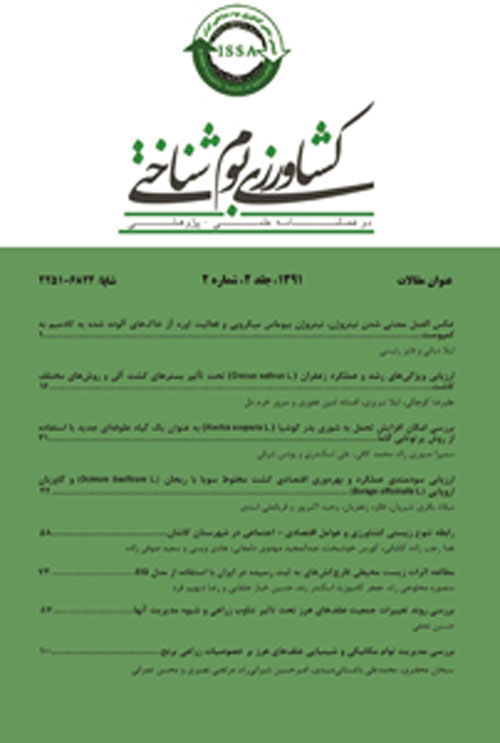The effect of nitrogen on yield and yield components of maize (Zea maysL.) under competition with redroot pigweed (Amaranthus retroflexus L.)and proso-millet (Panicum miliaceumL.)
Author(s):
Abstract:
Determination of the best amount of n itrogen (N) fertilizer appl ication in maize that results in h igh grain yieldunderweed competition is of great importance. In order to study the effect of weed competi tion on ma ize performanceandidentifying whether or not N application rate affects by weed species, an experiment was conducted in 2008 at the Research Field of Tarbiat Modares University. The experi ment was establ ished as a randomized completeblockdesign with factorial arrangement of treatments and three repl ications. First factor was N fertil izer at the three following rates: 138, 184 and 230 kg N ha- 1. Second factor consisted of two weed species; i.e. redroot pigweedandproso-millet. Third factor was planting each weed species at low and high densities. Yield and yield components of maize was assessed atfinal harvest.Results indicated that weed competition significantly reduced maize grain yield compared to230kgN ha-1 controltreatment. Thehighest grain yield (1077gm-2) wasachieved intreatment 230kg N ha-1 whilethe lowestyieldsbelonged tohighdensitiesofredrootpigweed andproso-millet fertilized with 184and 230kgN ha-1,respectively (643and 565gm-2). Increasing milletdensity resulted in significant lossofmaize grain yield only.Maize grainyields in competition with lowdensitiesofproso-millet andpigweed were 800and 795gm- 2, respectively which reduced to 693gm-2 when weed densities increased. Difference in N application rate did not cause significant differences in yield components of maize under weed competition. However, high densities of proso-millet and redroot pigweed resulted in significant reductions ofthenumber ofrows per earand thenumberof grainsperrow,respectively. Overall, results indicated that in fieldswhere anitrophilespecies isthedominant weed species, increasingN application ratebeyond theoptimum ratenot onlydoesnot increase maize grain yield but also reduces its yield and causes pollution ofenvironment.
Keywords:
Language:
Persian
Published:
Journal of Agroecology, Volume:1 Issue: 2, 2012
Page:
17
https://www.magiran.com/p1410695
سامانه نویسندگان
از نویسنده(گان) این مقاله دعوت میکنیم در سایت ثبتنام کرده و این مقاله را به فهرست مقالات رزومه خود پیوست کنند.
راهنما
مقالات دیگری از این نویسنده (گان)
-
Biodiversity: A Pillar of National Security
*, Zeynab Hossein Nejad, Reyhaneh Zand
Iran Nature, May-Jun 2025 -
An algorithmic approach for determining the optimal sowing dates for crops in Iran
Seyedreza Amiri *, Elyas Soltani, Seyed Majid Alimagham, Alireza Nehbandani, Ebrahim Zeinali, Benjamin Torabi, , Sorayya Ghassemi, Omid Alasti, Amir Dadresi, Roghiyeh Alsadat Hosseini, Mahbobe Zahed, Hosna Fayazi, Hossein Kamari, Rahele Arab Ameri, Zahra Mohamadzadeh, Samaneh Rahban, Samane Mohamadi, Saleh Karamat, Afshin Soltani
Journal of Plant Production, Spring 2025


